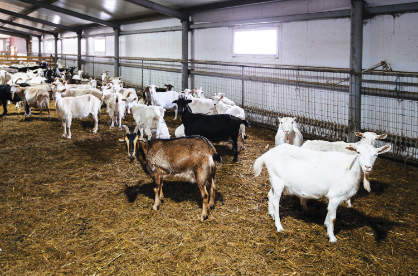Winter Care of Dairy Goats.

By Jennifer Bentley – Iowa State University Extension and Outreach Dairy Field Specialist.
Routine care such as feed availability, body condition score, and observation of health problems are important every day of the year for productive and healthy dairy goats. While goats are rather hardy animals, cold winter temperatures can bring another set of challenges and require careful attention to their health, comfort, and nutritional needs. Paying attention to the details will help identify small problems before they become larger problems, such as broken pipes, thin animals, sick kids, and empty wallets. Here are some important considerations for successfully caring for dairy goats during the cold months.
Housing and Ventilation
As with most animals, dairy goats can handle the cold temperatures if they have a shelter that is draft-free to get out of the wind. They will also do much better if they can avoid being wet. Ensure that the bedding is clean, dry, and deep enough to provide insulation and warmth. Healthy goats will grow a nice thick coat of hair in the fall, called an undercoat, that helps to keep the goat warm. Some breeds of dairy goats don’t have this undercoat and considerations for a fleece or other warm material type coat may be necessary depending on housing conditions. Check out a goat supply company for options or possibly a large breed dog coat may work.
Newborn kids are not able to maintain their body temperature very well. A high death loss is likely to occur if they are exposed to the wind chill and wet conditions. Heat lamps may provide additional heat, but caution safety in their use as not to come in contact with the bedding or allow kids to chew on the cord.
Goats will crowd together to maintain body warmth; however, this can increase the chances of injury and respiratory issues. It’s important to monitor the air quality within the shelter at the level where animals lay and breathe. Bedding may need to be replaced more frequently to allow for cleaner air and animal comfort. Evaluate the shelter for overcrowding issues and consider ventilation options to improve air quality.
Water
Water is an essential nutrient for animals to consume but can be challenging to consume in cold temperatures. Without it, animals can dehydrate, and become sick. A 100-pound goat will require 1 to 3 gallons of water per day depending on the diet, intake, and weather. A lactating goat will require an additional 0.5 gallons of water for every 2 pounds of milk produced. (Source: Dairy Goat Production Handbook).
Ensure that your goats have access to clean, unfrozen water at all times. Heated water buckets, tank heaters, or frost-free pumps can help prevent water from freezing. Pipes that have the potential to freeze should be insulated but remember to protect them from goats chewing on the insulation. Keep areas of water access free of ice and mud build up for safety of the animals.
Nutrition and Body Condition
As the temperatures decrease, energy requirements of goats will increase to maintain body temperature. Providing a good-quality hay will help generate heat through rumen digestion. Work with a nutritionist to evaluate nutritional needs of lactating and non-lactating animals and determine if additional energy-dense feed such as grain needs to be added or increased. Forages should be analyzed for minerals as well as energy and protein. Make these changes gradually while monitoring body condition score to ensure they are not becoming too thin or too fat, as both can impact their health and milk production. Free choice minerals and/or salt blocks are recommended to be always available to allow goats to consume as their body needs them.
Again, kid death loss can become high in extreme cold temperatures. Evaluate the milk or milk replacer feeding program to ensure they are consuming proper amounts of high-quality colostrum, milk, and starter. Avoid stressors like weaning, disbudding, or diet changes during extreme cold temperatures. Ideally, kids should be consuming at least 8 ounces of starter feed per day and weigh at least three times their birth weight at weaning. (Source: Dairy Goat Production Handbook).
Health and Routine Care
Cold weather can exacerbate existing health issues, so it is crucial to catch and resolve any problems early on. Monitor goats for frostbite in vulnerable areas such as their ears and udder and treat accordingly. Work with your local veterinarian to maintain a regular health check schedule. Regular health checks should include:
• Pregnancy check does early enough to rebreed if they are open.
• Booster vaccinations in mid to late lactation at least 6 weeks prior to kidding to promote high colostral antibody levels at kidding. In selenium deficient areas, booster vitamin E-Selenium in mid to late gestation, helps to prevent uterine inertia and retained placentas.
• Maintain desired body condition whiles still milking to reduce fresh doe problems like pregnancy toxemia.
• Routine foot care for all animals. Trim and treat hooves to prevent snow and ice buildup.
• Monitor goats for parasites such as lice, as it is very common in cold and damp conditions with less sunlight and can affect the whole herd quickly.
• Maintain records to evaluate animals that may need to be sold. This can help in reducing feed costs and other expenses to poor doers.
Exercise & Socialization
Exercise even in cold conditions is good for goats to keep their energy levels up, generate heat, and provide them a healthy appetite. Pregnant does should get plenty of exercise to keep them fit and trim, reducing metabolic disorders at freshening. Evaluate their exercise area to prevent injuries from slipping or getting ice or snow built up between their hooves. Goats are very social animals, so ensure they have companionship during the winter months to reduce stress and boredom.
By following these guidelines, you can help ensure that your dairy goats remain healthy and productive throughout the winter months. Regular monitoring and adjustments to their care will be essential to adapt to changing weather conditions.



